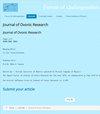PVA/Fe2O3/Se新型电子材料的设计与研究
IF 1.1
4区 材料科学
Q4 MATERIALS SCIENCE, MULTIDISCIPLINARY
引用次数: 0
摘要
本研究通过化学途径合成了一种新型的卵形纳米材料,该材料包括三种不同的材料:聚乙烯醇(PVA)、氧化铁(Fe2O3)和硒(Se)纳米颗粒。使用各种分析技术对生产的材料进行了评估,包括x射线衍射(XRD),能量色散x射线光谱(EDS),扫描电子显微镜(SEM)和紫外可见分光光度计。这项工作的重点是围绕一种独特的混合结构,该结构由嵌入聚乙烯醇和氧化铁(III)的硒纳米颗粒组成。微观结构信息的研究结果支持了Se纳米粒子对PVA/Fe2O3的结构性能有影响的观点。(XRD)和(EDS)检测证实了一种新型复合结构的形成。复合材料对PVA-Fe2O3-CdZnS在530 nm处有明显的吸收峰。这些复合材料表现出向更高波长区域吸收的渐进过渡。该复合材料已被建议在即将到来的储能应用中具有潜在的利用潜力。本文章由计算机程序翻译,如有差异,请以英文原文为准。
Designing and studying of PVA/Fe2O3/Se as new ovonic material for possible storage application
This study presents the synthesis of a novel ovonic nanomaterial by the chemical route approach, involving the combination of three distinct materials: polyvinyl alcohol (PVA), iron oxide (Fe2O3), and selenium (Se) nanoparticles. The produced material underwent evaluation using various analytical techniques, including Xray diffraction (XRD), energydispersive Xray spectroscopy (EDS), scaning electron microscope (SEM), and UV-Visible spectrophotometer. The focus of the work revolved around a unique hybrid structure consisting of selenium nanoparticles that were embedded within a polyvinyl alcohol and iron(III) oxide. The examination of micro structure information yielded findings that support the notion that Se nanoparticles have an impact on the structural properties of PVA/Fe2O3. (XRD) and (EDS) examines provided confirmation of the formation of a novel composite structure. The produced composites had notable absorption peaks at a wavelength of 530 nm for PVA-Fe2O3-CdZnS. These composites exhibited a progressive transition towards absorption in higher wavelength areas. The composite material that has been suggested for potential utilization in forthcoming energy storage applications.
求助全文
通过发布文献求助,成功后即可免费获取论文全文。
去求助
来源期刊

Journal of Ovonic Research
MATERIALS SCIENCE, MULTIDISCIPLINARY-PHYSICS, APPLIED
CiteScore
1.90
自引率
20.00%
发文量
77
期刊介绍:
Journal of Ovonic Research (JOR) appears with six issues per year and is open to the reviews, papers, short communications and breakings news inserted as Short Notes, in the field of ovonic (mainly chalcogenide) materials for memories, smart materials based on ovonic materials (combinations of various elements including chalcogenides), materials with nano-structures based on various alloys, as well as semiconducting materials and alloys based on amorphous silicon, germanium, carbon in their various nanostructured forms, either simple or doped/alloyed with hydrogen, fluorine, chlorine and other elements of high interest for applications in electronics and optoelectronics. Papers on minerals with possible applications in electronics and optoelectronics are encouraged.
 求助内容:
求助内容: 应助结果提醒方式:
应助结果提醒方式:


